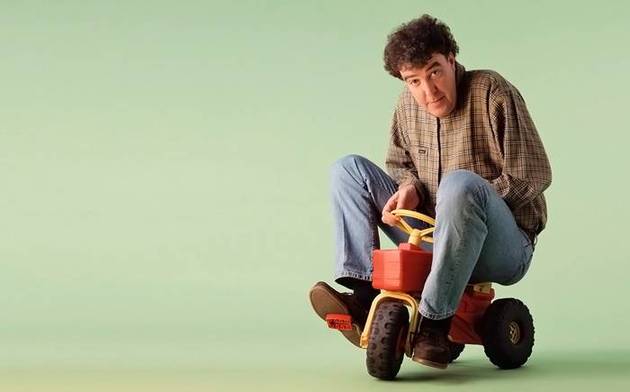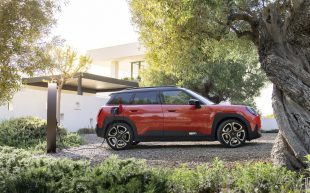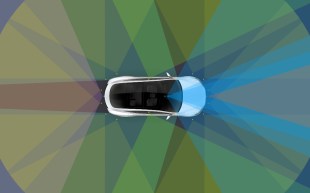20 years of Clarkson: Jeremy looks back at two decades of writing for The Sunday Times
The 1993 model was a terrible thing. And that’s just my hair
Twenty years. It’s a lifetime if you’re a bat or a beaver or a 20-year-old. But for me it’s been the blink of an eye: a moment. Not even half a lifetime. And nothing ever happens in a time frame that small.
The thing is, though, that if I asked my teenage children to manage with the technology we had in 1993, they’d be stumped. We communicated back then with letters, and gaming meant breaking out the Monopoly board. There was no LOL or HD or meh. And if you wanted to watch a television programme, you had to be in when it was on. Because the timer on your video recorder had a mind of its own.
The past 20 years have seen the world change faster than at any time in human history. The electronic revolution means we now have access to just about every fact just about constantly. We now take it for granted that we can take a photograph and publish it for all the world to see in a second. And if you want to find out where James Garner was born, you can, in an instant, even if you are driving through the deserts of Oman.
Of course, you might think that in this light-speed electronic rush, mechanical engineering had been left far behind. That cars were stuck in the last century, that kilobits per second was the new miles per hour.
You might think that if you drove tomorrow what you were driving back in 1993, it would feel pretty much the same as the car you have now. But it wouldn’t. Cars back then were closer to oxen than to the car that’s on your drive this morning.
They were fitted with steering wheels the size of Saturn’s rings. They were deeply uncomfortable and pretty much incapable of negotiating any corner at any speed. And they had none of the toys that we take for granted now. Sat nav, for instance, came in the shape of a book. And air-conditioning meant opening the window. Sometimes, even in 1993, this had to be done with a handle.
Of course, you had suspension in 1993, but it was nothing like the suspension systems of today — shock absorbers filled with iron filings that respond to magnetic inputs, thus firming up the system when required. That wasn’t science fiction in 1993. It hadn’t been thought of at all.
“Back then there was one speed camera, in Twickenham. If you lived somewhere else, you were only ever stopped by something called a bobby”
What we drive has changed too. Twenty years ago we had TVR and MG and Rover and Saab. Brands of car that are gone now. Either completely, or to China. Today pretty much everyone has a Hyundai. Or, as we used to call it back in 1993, “a what?!?!”.
The way we drive has changed as well. Back then there was one speed camera, in Twickenham. If you lived somewhere else, you were only ever stopped by something called a bobby. Who wore a belt to hold his trousers up, not as a device for suspending Taser guns, Glocks and pepper spray.
You could reason with traffic wardens then. You could be an amber gambler. You were allowed to eat a sandwich while driving. These were the days when “motoring” was considered to be easy, rather than a complicated series of events for which no human being is properly equipped.
Be in no doubt, then, that life on the roads has changed out of all recognition since I arrived on these pages with an Escort Cosworth and hair that, if anything, was even worse than it is now.
Like any old person, I’d like to say that life back then was better. And in some ways it was. Partly because the highway traffic officer hadn’t been invented in 1993. Which meant that after a minor accident the entire motorway wasn’t shut for six days. As a result you could estimate your time of arrival to the nearest five minutes, rather than the nearest month.
Mostly, though, life was better back then because the roads were chiefly for cars. Cycling was a hobby for children rather than a lifestyle statement. So you could go about your business without being shouted at constantly by some walnut-faced communist with gnarled buttocks and a head full of bile.
Overall, though, life for the motorist is better now. Chiefly because each new car is almost always better than the model it replaces. Safer. Faster. More comfortable. More economical. And, though it doesn’t really make a ha’p’orth of difference, more environmentally friendly.
“I am constantly updating the answer to the question I’m asked most of all: what’s the best car you’ve ever driven? I would have told you in 1994 it was the Ferrari 355 GTS. But it would be stupid to say that now”
The new Range Rover bears no relation to the original. And it’s the same story with the new Golf and the new Pagani. Which has just rewritten the rule book on the Top Gear test track, getting round in a time that even 10 years ago would have caused us to think the stopwatch had broken.
Cars are still mechanical. They are still moved about by a series of small explosions. But those explosions are governed by electronic engineering. That’s why they are getting better.
And that’s why I am constantly updating the answer to the question I’m asked most of all: what’s the best car you’ve ever driven?
I would have told you in 1994 it was the Ferrari 355 GTS. But it would be stupid to say that now because its modern-day equivalent is better in almost every single way.
To get the roof off a 355, you needed two people, a spine that moved sideways and several hundred pounds of cash money to replace the seats that you damaged while trying to thread the two-ton roof panel into the slot behind them. In a 458 Spider you just push a button.
Then there’s the speed. A 355 was jolly fast and we were all amazed that its V8 revved to 8000rpm. When a 458 gets to this point its engine is really only clearing its throat. Ready to run rings round any car from 1993.
A little later on I would have claimed that the Rolls-Royce Phantom was the best car in the world. BMW’s engineers used all that they knew when they were designing it. But because it’s broadly the same now as it was then, you get more electronic whizzbangery in a £30,000 1-series.
Since then there have been many best cars in the world. The Mercedes SLS held the crown briefly, as did the Ford GT. And the Aston Martin DBS. And now I would say it’s the Lexus LFA. Even though its long gestation highlights the problem of staying on top in a world that moves so fast. When it was conceived, 10 years ago, cars didn’t really have cupholders or blue teeth. So it doesn’t either. Mechanically it is a masterpiece, and I think it looks sensational. But there’s no getting away from the fact that the interior is like a really well-made cave.
So there we are. My favourite car from the past 20 years is a Lexus. But I very much doubt it will be my favourite after another 20 years. Partly because the best car then will be powered by hydrogen and guided by thought. But mostly because by 2033 I’ll probably be dead.






